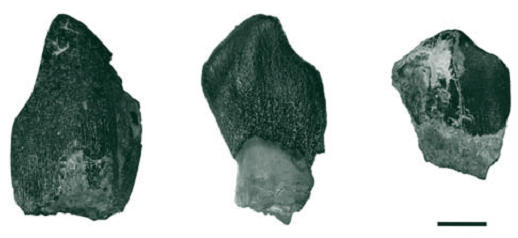Hoje, dia 1 de Maio, apresentamos no Dinosaur Journey Museum em Fruita (Colorado, Estados Unidos) no decorrer do congreso Mid-Mesozoic Conference a seguinte comunicação: "Geographic and stratigraphic distribution of the sauropod Turiasaurus and Turiasauria clade". Num estudo liderado pela Fundación Conjunto Paleotológico de Teruel - Dinópolis, conta ainda com a participação de investigadores da Sociedade de História Natural, os paleontólogos Pedro Mocho e Francisco Ortega. Neste trabalho, a distribuição paleobiogeográfica de Turiasauria (grupo de saurópodes mais primitivo que formas tão conhecidas como Diplodocus ou Camarasaurus) é colocada em evidência com o registo ibérico existente. Como é conhecido, existem diversas evidências de membros deste grupo em Portugal, com especial incidência nos conselhos de Peniche, Torres Vedras e Lourinhã, com destaque para uma pata anterior encontrada em Vale de Pombas e vários dentes descobertos ao longo da região costeira entre Porto da Calada e Salir do Porto. Deixamos aqui o resumo:
Dentes de Turiasauria encontrados na Bacia Lusitânica (Portugal) e incorporados na colecção paleontológica da Sociedade de História Natural
GEOGRAPHIC AND STRATIGRAPHIC DISTRIBUTION OF THE SAUROPOD TURIASAURUS AND TURIASAURIA CLADE
Rafael Royo-Torres, Alberto Cobos, Francisco Gascó, Pedro Mocho, Francisco Ortega, Luis Alcalá.
"Turiasauria clade represents a distinct group of non-neosauropods with a wide geographic distribution across Europe and probably Africa during the Middle-Late Jurassic. This clade is known thanks to the study of the sauropod dinosaur Turiasaurus riodevensis Royo-Torres, Cobos & Alcalá, 2006. It was discovered in 2003 in Riodeva, (Teruel province, South of Iberian Range, Spain). Turiasaurus is defined by the representative cranial and postcranial remains found in its type-locality: skull, mandible, eight teeth, six cervical vertebrae with ribs, four dorsal vertebrae, eight dorsal ribs, the sacrum, two distal caudal vertebrae, a proximal fragment of the left scapula, a left sternal, a complete left forelimb, fragments of ilium and ischium, a left pubis, a distal fragment of the left femur, a proximal and a distal fragments of the left tibia, a left fibula, two astragali and a pes. In addition, Riodeva area has yielded 3 other specimens of turiasaur sauropods. From one of them, the San Lorenzo specimen, there are cranial and postcranial remains, which are currently being studied. All the sites with turiasaur remains are placed in the Villar del Arzobispo Formation (dated Upper Kimmeridgian-Berriasian). Aside from the specimens of Riodeva, we tentatively assign materials from other localities to Turiasauria clade. Phylogenetic analyses support the attribution to Turiasauria of three sauropods: one from the Middle Jurassic of Beni Mellal (Moroco), Atlasaurus imelakei, and two species from the Upper Jurassic of Spain, Galveosaurus herreroi from Galve (Teruel) and Losillasaurus giganteus from Losilla (Valencia). Besides these taxa, and according to some synapomorphies, different specimens have been considered like potential turiasaurs. Turiasaurus possess characteristic ‘heart’-shaped teeth in labial profile with their apex labiolingually compressed, and with an asymmetrical shape produced by a concave distal margin near the apex even when unworn. This type of teeth allows the inclusion in Turiasauria of the Middle Jurassic of England tooth referred to Cardiodon, the Middle Jurassic of Peterborough (England) teeth assigned to “Cetiosauriscus leedsi”, four teeth from the Upper Jurassic of Aylesbury (England) assigned previously to “Hoplosaurus” and “Pelorosaurus”, some teeth from the Upper Jurassic of Asturias (Spain), and the teeth assigned to “Neosodon” in France. In Portugal, more than 26 Oxfordian-Tithonian teeth have been included in Turiasauria. Some of them are associated to an articulated forelimb and chevrons from the Lourinha Formation of Portugal. In Africa in addition to Atlasaurus, some of the postcranial material from Tendaguru beds (Kimmeridgian-Tithonian) in Tanzania has also been referred to Turiasauria, i.e. the caudal series of the specimen MB.R. 2091.1-30 and the right manus MB.R. 2093.1-12 (Museum für Naturkunde in Berlin). Thus, at present, Turiasauria is proposed as a distinct clade of sauropods that diverged, prior to the Middle Jurassic, from the lineage leading to neosauropods and which spread across Europe and Africa during the Late Jurassic. Turiasaurus represents a very large sauropod (over 25 m in length), suggesting that gigantic body sizes were achieved not only by neosauropod clades, such as Diplodocidae and Titanosauriformes, but also by non-neosauropods."------
Referência:



Sem comentários:
Enviar um comentário